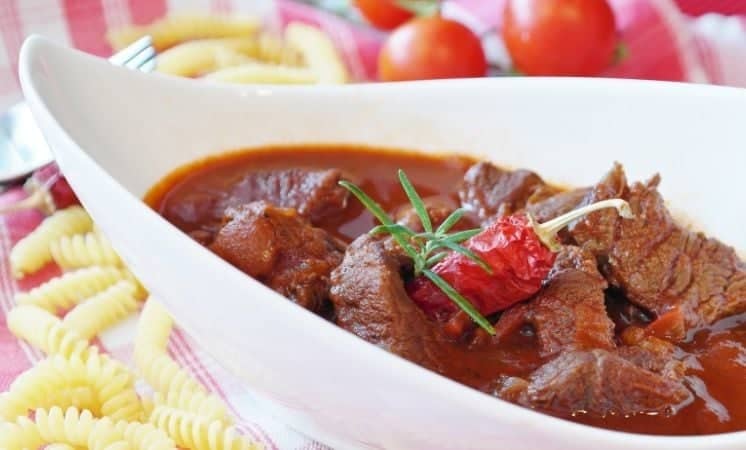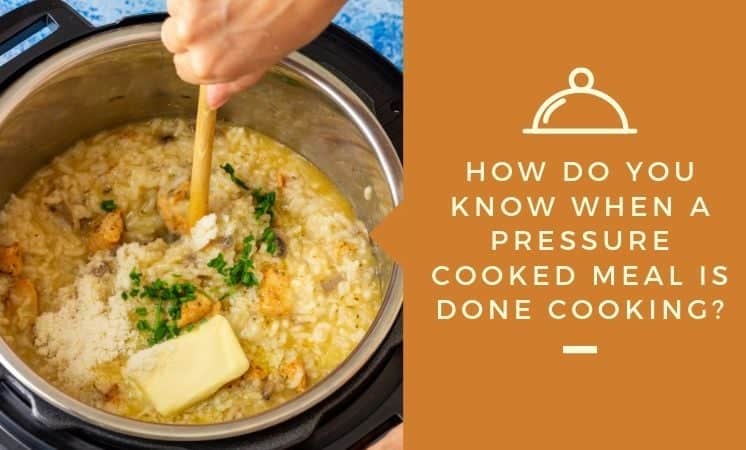To be able to seal a cooker shut is a double-edged sword in the sense that you can’t open it up halfway through to check on the food. Well, technically, you can open up the lid, but it would depressurize the cooker and increase the overall cooking time substantially. This means that any cooking done in a pressure cooker must be timed correctly to achieve the best results.
The same thing is true for air fryers, slow cookers and other conventional methods of cooking but they allow the user to make such adjustments on the go with ease.
Pressure cookers are unique in the way they cook. The build-up of steam pressure inside the cooker results in faster cooking times – by as much as 30%. The pressure cooker’s lid and the main unit are sealed shut and can’t be opened until the unit has depressurized. The lid is oftentimes made of stainless steel and doesn’t give the user a chance to keep an eye on the cooker’s content while it cooks.
So how do you know when a pressure cooker is done? To find out if your pressure cooker is done or not I recommend following recipes (there are thousands available online) and/or cooking times provided by the manufacturer at first, then make adjustments if needed. Other things, such as the aroma that escapes the cooker, can reveal how far along the food inside the cooker has come.
At first, I had trouble cooking in the pressure cooker without a recipe or clear guidelines – because I would either overcook or undercook food. Today, my two main tools are the ones I mentioned above but there are even more ways of doing it.
Keep reading to find out which ones – you may favor them over the methods I’ve used to keep track of my pressure cookers cooking cycle.
How Do I Check If the Food Inside My Pressure Cooker Is Done?

Because pressure cookers sealed shut and cut cooking times by up to 70% – they are quite different from many other methods of cooking. This has resulted in a steeper learning curve, which I believe is totally worth climbing because the benefits are awesome.
Here are a couple of ways to check if the food inside your pressure cooker is done.
- Open up the lid: Switching the venting knob from sealed to venting will cause the pressure cooker to release pressure. Once fully depressurized, the lid can be opened and the user can then check on the meal and if it needs more time or not. To resume cooking, seal the cooker and start the appliance. Doing this adds a couple of extra minutes to the total cooking time as the pressure must build up once again.
- Shake the cooker carefully: By moving the cooker you can get a feel of how much liquid there’s left in the cooker – this can give you an idea of how far the cooker has come.
- Smell the aroma: Every now and then the pressure cooker’s whistle will blow, and when it does, steam escapes the cooker. This steam carries the aromas that are kept inside the cooker. The further along the meal has come, the more intense the smell. This can be used as an indicator of how cooked the food is.
- Follow recipes: Following recipes is safe, and with the incredible amount of recipes available online – it is also an endless sea of opportunities. Start by following recipes until you get the hang of your cooker. Keep in mind that there are different sized pressure cookers and they require different amounts of liquid in order to pressurize.
- Read the instruction manual: Most instruction manuals come with a few guidelines for certain foods. Oftentimes, the instruction manual will give you the cooking time for 10-15 different ingredients. While I prefer to follow a recipe, the instruction manual is still a great source of information for both beginners and veterans.
- Consider altitude: At higher altitudes, the cooking time of foods increases significantly. There’s less atmospheric pressure which counters the effect of the pressure cooker – to a certain extent. Pressure cookers are still very effective at higher altitudes but recipes must be adjusted. At 3000ft, the cooking time of any meal should be increased by 5%, from there, add 5% for every 1000ft. For example, at 7000ft the cooking time should be increased by 25%.
- Listen to the whistles: Some pressure cookers, like the Hawkins collection, whistle on a regular basis. These whistles can be used as measurements. In perfect conditions, preparing a batch of lentils requires you to soak them for half an hour and then pressure cook them until you’ve heard 3 whistles. These cookers require manual temperature adjustments throughout the cooking cycle and are, all-in-all, not as convenient as their electric counterparts – in my opinion.
How To Open a Pressure Cooker?
You must take the time it takes to release the pressure and open up the pressure cooker into consideration when timing your meals. First, the cooker takes anywhere between 5-30 minutes to build pressure, depending on a variety of different things. I’ve outlined them in this article which goes more in-depth on the topic.
Then, when you’ve finished cooking, the cooker must depressurize before opening the lid. Forcing the lid open when the cooker is pressurized can send the lid and the cooker’s contents flying all over your kitchen. That’s something you definitely want to avoid. The food inside the cooker is most likely hot enough to burn the user, and so is the steam.
Instead, the pressure inside the cooker should be released naturally – by letting the cooker sit for 25-30 minutes after cooking, or quickly be “venting” the cooker.
Switching the venting knob from sealed to venting will open up an escape route for the trapped steam. Remember, hot steam will blast through the hole once you’ve opened it so be careful of where you place your hands to avoid getting burned.
The venting or quick release method will depressurize your cooker in no more than 5 minutes.
Both are perfectly fine to use, it comes down to what kind of foods you’re cooking and how long you’ve cooked them. Things that you don’t want to overcook should most likely be removed from the cooker as soon as possible after cooking them, therefore, quickly releasing the pressure is the most suitable option in that situation.
When cooking meat you can actually benefit from letting it sit in the cooker for an additional 30 minutes because it makes it extra tender and juicy, which I think is delicious.
The actual cooking time is reduced in the pressure cooker. But even though the pressure cooker takes time to build up pressure and then release it, it’s still faster than many other methods of cooking.
Tips When Using a Pressure Cooker For the First Time
Your pressure cooker will let out steam, there’s nothing wrong with it: I know a lot of users think there’s something wrong with their cooker when they notice that it releases steam while cooking, isn’t it supposed to trap it? Well, the cooker must let out excessive steam to avoid exploding. You can’t trap endless amounts of pressure in a small vessel.
Make sure to add enough liquid to avoid burning the bottom of the cooker: If the amount of liquid added to the cooker doesn’t suffice, the food in the cooker will eventually scorch. Some foods release liquids when heated, others absorb it. It’s important that you keep things like this into consideration when using the pressure cooker. The minimum amount of liquid is somewhere around 1 cup of water.
Adding excessive amounts of water will reduce the intensity of the flavor. Try to balance it out as perfectly as possible.
I’ve written an article on Instant Pots and what you should do to avoid burning food to the bottom of the insert. These tips also apply to regular pressure cookers. I recommend you check it out.
When cooking ingredients that produce foam, don’t overfill the cooker: Things like beans, rice, and lentils will generate foam while cooking. If the cooker is overfilled, the foam will make its way up to the release hole and eventually clog it. This stops the excess pressure from escaping the cooker – which may be dangerous. I recommend filling the cooker halfways when cooking ingredients that expand or generate foam.
You Can Check On Your Food Halfway Through
Finally, I would like to add that there’s nothing wrong with opening the cooker (once it has depressurized) to add more water or check on your food. Yes, it’s harder to make adjustments when cooking in a pressure cooker but there’s nothing that stops you from actually doing it.
The only downside is that it takes more time. But that’s your time, not mine or anyone else’s. If you feel safer opening the cooker to check on the food, go ahead.
When you resume cooking, the cooker will actually build up pressure much quicker because the liquids inside the cooker are already hot enough to produce steam pressure once the lid is sealed.

